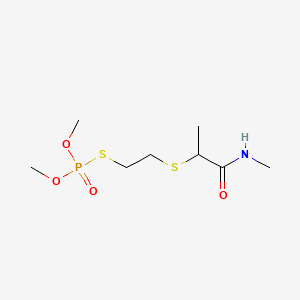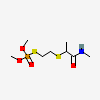Vamidothion
- VAMIDOTHION
- 2275-23-2
- Vamidoate
- Kilval
- Trucidor
- Create:2005-03-27
- Modify:2025-01-11

- Kilval
- O,O-dimethyl S-(2-(1-methylcarbamoylethylthio)ethyl)phosphorothioate
- vamidothion
- VAMIDOTHION
- 2275-23-2
- Vamidoate
- Kilval
- Trucidor
- American cyanamid-43073
- NPH 83
- ENT 26,613
- Dimethyl S-(2-(1-methylcarbamoylethylthio)ethyl) phosphorothiolate
- O,O-Dimethyl S-(2-(1-methylcarbamoylethylthio)ethyl) phosphorothioate
- R.P. 10,465
- 2-(2-Dimethoxyphosphinoylthioethylthio)-N-methylpropionamide
- O,O-Dimethyl S-2-(1-N-methylcarbamoylethylmercapto)ethyl thiophosphate
- 2-(2-dimethoxyphosphorylsulfanylethylsulfanyl)-N-methylpropanamide
- N-Methyl O,O-dimethylthiolophosphoryl-5-thia-3-methyl-2-valeramide
- H1G712H762
- Vamidothion 100 microg/mL in Acetonitrile
- N-Methyl-3-thia-2-methyl-valeramid der O,O-dimethylthiolphosphorsaeure
- Phosphorothioic acid, O,O-dimethyl ester, S-ester with 2-((2-mercaptoethyl)thio)-N-methylpropionamide
- Phosphorothioic acid, O,O-dimethyl S-(2-((1-methyl-2-(methylamino)-2-oxoethyl)thio)ethyl) ester
- Bamidothion
- Caswell No. 379A
- Vamidothion [BSI:ISO]
- O,O-Dimethyl S-[2-(1-methylcarbamoylethylthio)ethyl] phosphorothioate
- O,O-dimethyl S-(2-((1-(methylamino)-1-oxopropan-2-yl)thio)ethyl) phosphorothioate
- O,O-dimethyl S-(2-{[1-methyl-2-(methylamino)-2-oxoethyl]sulfanyl}ethyl) phosphorothioate
- O,O-dimethyl S-(2-{[1-methyl-2-(methylamino)-2-oxoethyl]sulfanyl}ethyl) thiophosphate
- Phosphorothioic acid, O,O-dimethyl ester, S-ester with 2-[(2-mercaptoethyl)thio]-N-methylpropionamide
- Phosphorothioic acid, O,O-dimethyl S-[2-[[1-methyl-2-(methylamino)-2-oxoethyl]thio]ethyl] ester
- Vamidothion [ISO]
- CCRIS 1305
- HSDB 6746
- 10465 rp
- EINECS 218-894-8
- EPA Pesticide Chemical Code 379200
- RP-9895
- BRN 2651123
- AI3-25761
- Dimethyl S-[2-(1-methylcarbamoylethylthio)ethyl] phosphorothiolate
- UNII-H1G712H762
- RP 9895
- VAMIDOATE [HSDB]
- N-Methyl-3-thia-2-methyl-valeramid der O,O-dimethylthiolphosphorsaeure [German]
- O,O-Dimethyl phosphorothioate S-ester with 2-((2-mercaptoethyl)thio)-N-methylpropionamide
- SCHEMBL115738
- DTXSID7042510
- CHEBI:38990
- AKOS015960756
- O,O-Dimethyl S-(2-((1-methyl-2-(methylamino)-2-oxoethyl)thio)ethyl) phosphorothioate
- AC-12149
- DB-045982
- NS00049873
- C18666
- Q290452
- J-014842
- dimethyl [(2-{[1-(methylcarbamoyl)ethyl]sulfanyl}ethyl)sulfanyl]phosphonate
- N-METHYL O,O-DIMETHYLTHIOLOPHOSPHORYL-5-THIA-3-METHYL-2- VALERAMIDE
- O,O-Dimethyl S-(2-([1-methyl-2-(methylamino)-2-oxoethyl]sulfanyl)ethyl) thiophosphate #
- O,O-dimethyl S-2-(1-(methylamino)-1-oxopropan-2-ylthio)ethyl phosphorothioate
- O,O-DIMETHYL PHOSPHOROTHIOATE S-ESTER WITH 2-((2- MERCAPTOETHYL)THIO)-N-METHYLPROPIONAMIDE
- O,O-DIMETHYL S-(2-((1-METHYL-2-(METHYLAMINO)-2- OXOETHYL)THIO)ETHYL) PHOSPHOROTHIOATE
- Pesticide1_Vamidothion_C8H18NO4PS2_Phosphorothioic acid, O,O-dimethyl S-[2-[[1-methyl-2-(methylamino)-2-oxoethyl]thio]ethyl] ester
146.0633 999
118.0322 5
146.0633 999
118.0321 136
58.0651 36
86.0599 30
58.0289 8


H301 (100%): Toxic if swallowed [Danger Acute toxicity, oral]
H312 (100%): Harmful in contact with skin [Warning Acute toxicity, dermal]
H400 (100%): Very toxic to aquatic life [Warning Hazardous to the aquatic environment, acute hazard]
P264, P270, P273, P280, P301+P316, P302+P352, P317, P321, P330, P362+P364, P391, P405, and P501
(The corresponding statement to each P-code can be found at the GHS Classification page.)
Aggregated GHS information provided per 41 reports by companies from 1 notifications to the ECHA C&L Inventory. Each notification may be associated with multiple companies.
Information may vary between notifications depending on impurities, additives, and other factors. The percentage value in parenthesis indicates the notified classification ratio from companies that provide hazard codes. Only hazard codes with percentage values above 10% are shown.
Acute Tox. 3 (100%)
Acute Tox. 4 (100%)
Aquatic Acute 1 (100%)
Acute toxicity (ingestion) - category 3
Acute toxicity (dermal) - category 4
Hazardous to the aquatic environment (acute) - category 1
IMAP assessments - Phosphorothioic acid, O,O-dimethyl S-[2-[[1-methyl-2-(methylamino)-2-oxoethyl]thio]ethyl] ester: Environment tier I assessment
IMAP assessments - Phosphorothioic acid, O,O-dimethyl S-[2-[[1-methyl-2-(methylamino)-2-oxoethyl]thio]ethyl] ester: Human health tier I assessment
Patents are available for this chemical structure:
https://patentscope.wipo.int/search/en/result.jsf?inchikey=LESVOLZBIFDZGS-UHFFFAOYSA-N
- Australian Industrial Chemicals Introduction Scheme (AICIS)Phosphorothioic acid, O,O-dimethyl S-[2-[[1-methyl-2-(methylamino)-2-oxoethyl]thio]ethyl] esterhttps://services.industrialchemicals.gov.au/search-assessments/
- CAS Common ChemistryLICENSEThe data from CAS Common Chemistry is provided under a CC-BY-NC 4.0 license, unless otherwise stated.https://creativecommons.org/licenses/by-nc/4.0/
- ChemIDplusVamidothion [BSI:ISO]https://pubchem.ncbi.nlm.nih.gov/substance/?source=chemidplus&sourceid=0002275232ChemIDplus Chemical Information Classificationhttps://pubchem.ncbi.nlm.nih.gov/source/ChemIDplus
- EPA DSSToxCompTox Chemicals Dashboard Chemical Listshttps://comptox.epa.gov/dashboard/chemical-lists/
- European Chemicals Agency (ECHA)LICENSEUse of the information, documents and data from the ECHA website is subject to the terms and conditions of this Legal Notice, and subject to other binding limitations provided for under applicable law, the information, documents and data made available on the ECHA website may be reproduced, distributed and/or used, totally or in part, for non-commercial purposes provided that ECHA is acknowledged as the source: "Source: European Chemicals Agency, http://echa.europa.eu/". Such acknowledgement must be included in each copy of the material. ECHA permits and encourages organisations and individuals to create links to the ECHA website under the following cumulative conditions: Links can only be made to webpages that provide a link to the Legal Notice page.https://echa.europa.eu/web/guest/legal-noticeVamidothion (EC: 218-894-8)https://echa.europa.eu/information-on-chemicals/cl-inventory-database/-/discli/details/134242
- FDA Global Substance Registration System (GSRS)LICENSEUnless otherwise noted, the contents of the FDA website (www.fda.gov), both text and graphics, are not copyrighted. They are in the public domain and may be republished, reprinted and otherwise used freely by anyone without the need to obtain permission from FDA. Credit to the U.S. Food and Drug Administration as the source is appreciated but not required.https://www.fda.gov/about-fda/about-website/website-policies#linking
- Hazardous Substances Data Bank (HSDB)
- ILO-WHO International Chemical Safety Cards (ICSCs)
- ChEBI
- EU Pesticides Database
- Haz-Map, Information on Hazardous Chemicals and Occupational DiseasesLICENSECopyright (c) 2022 Haz-Map(R). All rights reserved. Unless otherwise indicated, all materials from Haz-Map are copyrighted by Haz-Map(R). No part of these materials, either text or image may be used for any purpose other than for personal use. Therefore, reproduction, modification, storage in a retrieval system or retransmission, in any form or by any means, electronic, mechanical or otherwise, for reasons other than personal use, is strictly prohibited without prior written permission.https://haz-map.com/AboutVamidothionhttps://haz-map.com/Agents/7702
- USDA Pesticide Data ProgramVamidothionhttps://www.ams.usda.gov/datasets/pdp
- Hazardous Chemical Information System (HCIS), Safe Work Australia
- NITE-CMCO,O-Dimethyl S-2-[1-(N-methylcarbamoyl)ethylthio]ethyl phosphorothioate; Vamidothion - FY2006 (New/original classication)https://www.chem-info.nite.go.jp/chem/english/ghs/06-imcg-0290e.htmlO,O-Dimethyl S-2-[1-(N-methylcarbamoyl)ethylthio]ethyl phosphorothioate; Vamidothion - FY2020 (Revised classification)https://www.chem-info.nite.go.jp/chem/english/ghs/20-mhlw-2051e.html
- Regulation (EC) No 1272/2008 of the European Parliament and of the CouncilLICENSEThe copyright for the editorial content of this source, the summaries of EU legislation and the consolidated texts, which is owned by the EU, is licensed under the Creative Commons Attribution 4.0 International licence.https://eur-lex.europa.eu/content/legal-notice/legal-notice.htmlvamidothion (ISO); O,O-dimethyl S-2-(1-methylcarbamoylethylthio) ethyl...https://eur-lex.europa.eu/eli/reg/2008/1272/oj
- Japan Chemical Substance Dictionary (Nikkaji)
- KEGGLICENSEAcademic users may freely use the KEGG website. Non-academic use of KEGG generally requires a commercial licensehttps://www.kegg.jp/kegg/legal.html
- Kruve Lab, Ionization & Mass Spectrometry, Stockholm Universityvamidothion
- MassBank Europe
- MassBank of North America (MoNA)LICENSEThe content of the MoNA database is licensed under CC BY 4.0.https://mona.fiehnlab.ucdavis.edu/documentation/licensePesticide1_Vamidothion_C8H18NO4PS2_Phosphorothioic acid, O,O-dimethyl S-[2-[[1-methyl-2-(methylamino)-2-oxoethyl]thio]ethyl] esterhttps://mona.fiehnlab.ucdavis.edu/spectra/browse?query=exists(compound.metaData.name:%27InChIKey%27%20and%20compound.metaData.value:%27LESVOLZBIFDZGS-UHFFFAOYSA-N%27)
- Metabolomics Workbench
- NIST Mass Spectrometry Data CenterLICENSEData covered by the Standard Reference Data Act of 1968 as amended.https://www.nist.gov/srd/public-lawVamidothionhttp://www.nist.gov/srd/nist1a.cfm
- SpectraBaseVamidothionhttps://spectrabase.com/spectrum/5gVfE1BlW2dVamidothionhttps://spectrabase.com/spectrum/Gfz7ok3siLeVAMIDOTHION PESTANALhttps://spectrabase.com/spectrum/4efqILaZF13
- Springer Nature
- Wikidatavamidothionhttps://www.wikidata.org/wiki/Q290452
- PubChem
- Medical Subject Headings (MeSH)LICENSEWorks produced by the U.S. government are not subject to copyright protection in the United States. Any such works found on National Library of Medicine (NLM) Web sites may be freely used or reproduced without permission in the U.S.https://www.nlm.nih.gov/copyright.htmlvamidothionhttps://www.ncbi.nlm.nih.gov/mesh/67005870
- GHS Classification (UNECE)GHS Classification Treehttp://www.unece.org/trans/danger/publi/ghs/ghs_welcome_e.html
- NORMAN Suspect List ExchangeLICENSEData: CC-BY 4.0; Code (hosted by ECI, LCSB): Artistic-2.0https://creativecommons.org/licenses/by/4.0/NORMAN Suspect List Exchange Classificationhttps://www.norman-network.com/nds/SLE/
- EPA Substance Registry ServicesEPA SRS List Classificationhttps://sor.epa.gov/sor_internet/registry/substreg/LandingPage.do
- MolGenieMolGenie Organic Chemistry Ontologyhttps://github.com/MolGenie/ontology/
- PATENTSCOPE (WIPO)SID 403408799https://pubchem.ncbi.nlm.nih.gov/substance/403408799



